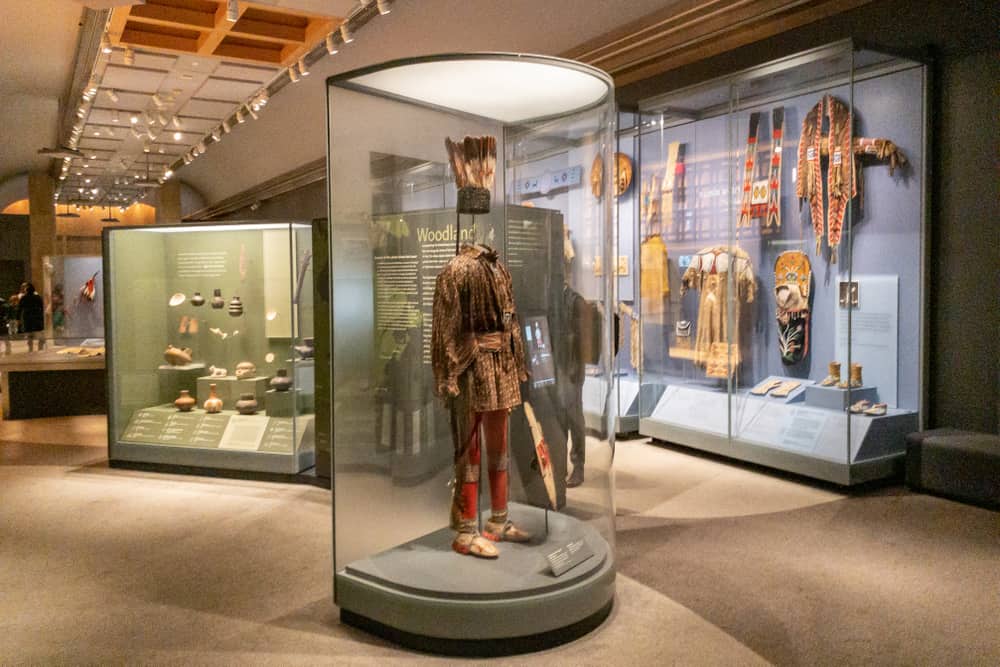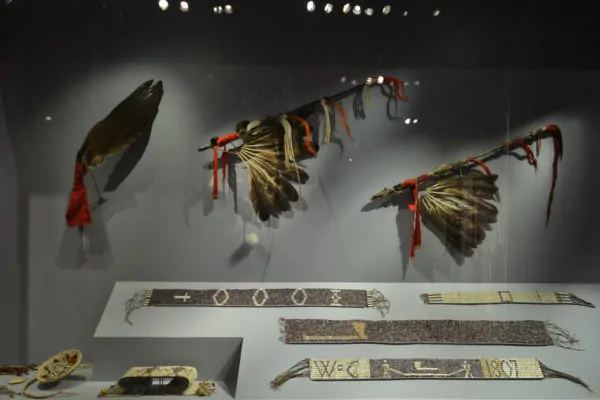
Native American Museum Permanent Collection Highlights: An In-Depth Encyclopedic Exploration
The permanent collections of Native American museums and institutions with significant Indigenous holdings represent an invaluable repository of cultural heritage, artistic achievement, and historical documentation. Far from being mere ethnographic curiosities, these collections serve as vibrant testaments to the enduring resilience, profound spirituality, and intricate knowledge systems of over 574 federally recognized and numerous un-recognized Native American tribes across North America. This exploration delves into the highlights of these collections, examining their significance through an educational and scholarly lens, akin to an encyclopedia article.
The Diverse Landscape of Native American Collections
Native American collections are housed in a diverse array of institutions, each with a unique history and curatorial philosophy. These include:
- Dedicated Native American Museums: Institutions like the Smithsonian’s National Museum of the American Indian (NMAI) in Washington D.C., New York, and Suitland, MD, are unique in their mission to represent Indigenous voices and perspectives, often developed in close consultation with Native communities.
- Tribal Museums and Cultural Centers: Owned and operated by specific tribes (e.g., Mashantucket Pequot Museum & Research Center, Oglala Lakota College Historical Center), these institutions prioritize community self-representation, cultural revitalization, and direct engagement with their own histories and traditions.
- General Art and History Museums: Major institutions such as the Metropolitan Museum of Art, the American Museum of Natural History (AMNH), the Field Museum, and the Peabody Museum of Archaeology and Ethnology at Harvard University hold vast historical collections, many acquired during the late 19th and early 20th centuries. These collections are increasingly subject to re-evaluation, decolonization efforts, and repatriation initiatives under laws like the Native American Graves Protection and Repatriation Act (NAGPRA).
- University Museums and Research Institutions: Often focused on anthropological or archaeological research, these collections contribute significantly to scholarly understanding but also face ongoing ethical considerations regarding their provenance and interpretation.

Regardless of their institutional home, the most compelling highlights across these collections share common threads: exceptional artistry, profound cultural significance, and the ability to convey complex narratives of identity, adaptation, and survival.
Key Categories of Collection Highlights
The highlights within Native American permanent collections can be broadly categorized by material, function, and cultural significance, often blurring the lines between art, utility, and ceremony.
1. Textiles and Weavings: Threads of Culture and History

Native American textiles are renowned for their intricate designs, sophisticated weaving techniques, and deep cultural narratives.
- Navajo (Diné) Blankets and Rugs: Perhaps the most iconic, Navajo weaving represents centuries of innovation. Early examples, such as the "Chief’s Blankets" (first phase, second phase, third phase), are celebrated for their elegant banded designs, later evolving into complex geometric patterns. Weavers like the legendary Isabel John (Hastiin Klah) incorporated sacred Yeibichai ceremonial figures into rugs, a practice that became controversial but showcased profound artistic and spiritual engagement. These textiles are not merely decorative but embody cultural identity, economic prowess, and spiritual connection to the land.
- Pueblo Textiles: Weavings from Pueblo communities like the Hopi and Zuni often feature distinctive patterns and colors, reflecting ancient traditions. Pre-contact cotton textiles, preserved in arid environments, demonstrate advanced techniques.
- Chilkat Blankets (Tlingit, Haida, Tsimshian): From the Northwest Coast, Chilkat blankets are unique in their "formline" design—a curvilinear style often depicting clan crests and spirit beings. Woven from mountain goat wool and cedar bark, their complex construction and ceremonial use make them highly prized.
2. Ceramics and Pottery: Vessels of Tradition
Native American pottery traditions are among the oldest and most diverse art forms, often reflecting environmental resources and spiritual beliefs.
- Southwestern Pueblo Pottery: Communities like Acoma, Hopi, Zuni, Santa Clara, and San Ildefonso have distinct pottery traditions. The black-on-black pottery revived by Maria and Julian Martinez of San Ildefonso Pueblo in the early 20th century, with its matte and polished surfaces, is a celebrated example of artistic innovation within tradition. Ancient Mimbres pottery, known for its striking black-on-white narrative designs, particularly bowls depicting human and animal figures, offers insights into pre-contact belief systems.
- Mississippian Culture Effigy Pots: Archaeological sites in the Southeastern United States yield sophisticated effigy pots, often depicting human heads or animals, used in ceremonial contexts. These demonstrate advanced ceramic technology and complex iconographies.
3. Sculpture and Carving: Embodied Narratives
Carving traditions across Native America range from monumental totemic structures to intricate personal adornments.
- Pacific Northwest Coast Totem Poles and Masks: These monumental carvings, typically from cedar, serve as visual genealogies, clan crests, and storytelling devices. They embody spiritual beliefs, social hierarchies, and historical events. Ceremonial masks, often depicting transformative beings, are central to winter ceremonials and potlatches, conveying profound spiritual power.
- Plains Effigy Pipes (Calumets): Carved from sacred catlinite (pipestone), these pipes are not merely smoking devices but sacred instruments for prayer, diplomacy, and ceremony. Their bowls are often carved into animal or human forms, representing spiritual connections.
- Inuit Carvings: From the Arctic, Inuit carvings in soapstone, ivory, and bone depict animals, hunters, and mythological figures, reflecting a deep connection to the environment and spiritual world. Their tactile quality and expressive forms are highly distinctive.
4. Beadwork and Quillwork: Adornment and Symbolism
These labor-intensive art forms transform functional items into objects of exquisite beauty and profound cultural meaning.
- Plains Beadwork: Using glass beads introduced through trade, Plains tribes (e.g., Lakota, Crow, Blackfeet) created intricate designs on clothing, moccasins, bags, and regalia. Geometric patterns, floral motifs, and narrative designs often carry specific meanings related to clan, status, and spiritual power. Early examples utilizing porcupine quills, a precursor to beadwork, demonstrate equally sophisticated techniques.
- Great Lakes Quillwork: Before the widespread availability of glass beads, tribes like the Anishinaabe (Ojibwe) and Haudenosaunee (Iroquois) perfected the art of quillwork, dyeing and flattening porcupine quills to create decorative patterns on birchbark, leather, and fabric.
5. Personal Adornment and Regalia: Identity and Status
Objects of personal adornment and ceremonial regalia are central to expressing identity, status, and spiritual beliefs.
- Southwestern Jewelry: Navajo, Zuni, and Hopi silver and turquoise jewelry are world-renowned. Navajo silversmiths are known for their heavy gauge silver and intricate stone settings, while Zuni artists excel in lapidary work like channel inlay and cluster work. Hopi overlay jewelry features cut-out designs revealing an oxidized background. These pieces are not just fashion but expressions of cultural identity, wealth, and connection to the land.
- Headdresses and War Bonnets: While often generalized, specific Plains headdresses, particularly the "war bonnet" adorned with eagle feathers, are powerful symbols of honor, bravery, and leadership, each feather earned through specific deeds. Their proper display and understanding require careful cultural context.
- Dentalium Shell Money and Adornment: Along the Pacific Coast and into the Great Basin, dentalium shells served as a form of currency and adornment, reflecting ancient trade networks and social status.
6. Tools, Weapons, and Utilitarian Objects: Ingenuity and Adaptation
Even everyday items demonstrate remarkable ingenuity, artistic sensibility, and deep ecological knowledge.
- Baskets: From the intricate coiled baskets of California tribes (e.g., Pomo, Miwok) to the twined baskets of the Pacific Northwest (e.g., Tlingit, Haida) and the functional utilitarian baskets of the Great Basin, Native American basketry is an astonishing testament to mastery of natural materials and complex weaving techniques. Each style reflects regional plant resources and cultural practices.
- Birchbark Canoes and Containers: Northeast and Great Lakes tribes crafted elegant, lightweight, and durable canoes and containers from birchbark, demonstrating sophisticated engineering and resourcefulness.
- Pre-Contact Stone Tools: Collections often include meticulously crafted projectile points (e.g., Clovis, Folsom), atl-atls, and other lithic tools, providing crucial insights into ancient technologies, hunting strategies, and early human presence in North America.
7. Pictorial and Graphic Arts: Documenting Life and Belief
Native American pictorial traditions span millennia, from ancient rock art to contemporary canvas.
- Ledger Art: Originating in the Plains during the reservation era, Ledger art saw warriors and artists adapting traditional hide painting to paper ledgers, depicting historical events, personal narratives, and cultural practices during a period of immense change. These provide invaluable first-hand accounts.
- Petroglyphs and Pictographs: While often found in situ, museums may house detailed reproductions or extensive photographic documentation of ancient rock art sites, which serve as enduring records of spiritual beliefs, astronomical observations, and historical events.
8. Contemporary Native Art: Living Traditions
A crucial, and often growing, highlight of modern collections is contemporary Native American art. This includes works by artists who explicitly engage with traditional forms and materials while exploring modern themes, as well as those working in contemporary Western art genres. Artists like T.C. Cannon, Jaune Quick-to-See Smith, Kay WalkingStick, Kent Monkman, and Jeffrey Gibson demonstrate the vitality, innovation, and ongoing relevance of Indigenous perspectives in the global art world. Their work challenges stereotypes, addresses historical trauma, and celebrates cultural resilience.
Ethical Considerations and Future Directions
The interpretation and display of Native American permanent collections are continually evolving. Key ethical considerations include:
- Repatriation: The ongoing return of human remains, funerary objects, sacred objects, and objects of cultural patrimony to lineal descendants and culturally affiliated tribes under NAGPRA and similar international agreements is a paramount ethical imperative.
- Decolonization of Narratives: Museums are increasingly moving away from purely anthropological or colonial interpretations, striving to present Indigenous perspectives, voices, and knowledge systems. This involves collaborative curation, self-representation, and acknowledging the often-problematic histories of collection acquisition.
- Access and Digitalization: Expanding access to collections through digital platforms and research initiatives ensures wider engagement and facilitates scholarly and community-based research.
Conclusion
The permanent collections of Native American museums and related institutions offer an unparalleled journey into the rich tapestry of Indigenous cultures. From the intricate weaves of a Navajo blanket to the powerful carvings of a Northwest Coast mask, and from ancient pottery to vibrant contemporary art, these highlights transcend mere artifact status. They are living embodiments of cultural identity, spiritual profundity, artistic mastery, and enduring resilience. By engaging with these collections, visitors gain a deeper understanding of the diverse histories, ongoing vitality, and profound contributions of Native American peoples to the global human story. The ongoing work of curation, interpretation, and repatriation ensures that these treasures will continue to educate, inspire, and foster respect for generations to come.


